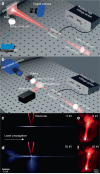Stable, intense supercontinuum light generation at 1 kHz by electric field assisted femtosecond laser filamentation in air
- PMID: 38307847
- PMCID: PMC10837124
- DOI: 10.1038/s41377-023-01364-3
Stable, intense supercontinuum light generation at 1 kHz by electric field assisted femtosecond laser filamentation in air
Abstract
Supercontinuum (SC) light source has advanced ultrafast laser spectroscopy in condensed matter science, biology, physics, and chemistry. Compared to the frequently used photonic crystal fibers and bulk materials, femtosecond laser filamentation in gases is damage-immune for supercontinuum generation. A bottleneck problem is the strong jitters from filament induced self-heating at kHz repetition rate level. We demonstrated stable kHz supercontinuum generation directly in air with multiple mJ level pulse energy. This was achieved by applying an external DC electric field to the air plasma filament. Beam pointing jitters of the 1 kHz air filament induced SC light were reduced by more than 2 fold. The stabilized high repetition rate laser filament offers the opportunity for stable intense SC generation and its applications in air.
© 2024. The Author(s).
Conflict of interest statement
The authors declare no competing interests.
Figures









References
-
- Alfano RR, Shapiro SL. Observation of self-phase modulation and small-scale filaments in crystals and glasses. Phys. Rev. Lett. 1970;24:592–594. doi: 10.1103/PhysRevLett.24.592. - DOI
-
- Brabec T, Krausz F. Intense few-cycle laser fields: frontiers of nonlinear optics. Rev. Mod. Phys. 2000;72:545–591. doi: 10.1103/RevModPhys.72.545. - DOI
-
- Smirnov SV, et al. Optical spectral broadening and supercontinuum generation in telecom applications. Opt. Fiber Technol. 2006;12:122–147. doi: 10.1016/j.yofte.2005.07.004. - DOI
Grants and funding
- U2130123/National Science Foundation of China | NSAF Joint Fund
- 181231KYSB20200033/Bureau of International Cooperation, Chinese Academy of Sciences
- 181231KYSB20200040/Bureau of International Cooperation, Chinese Academy of Sciences
- 21511105000/Shanghai Science and Technology Development Foundation (Shanghai Science and Technology Development Fund)
LinkOut - more resources
Full Text Sources
Other Literature Sources

